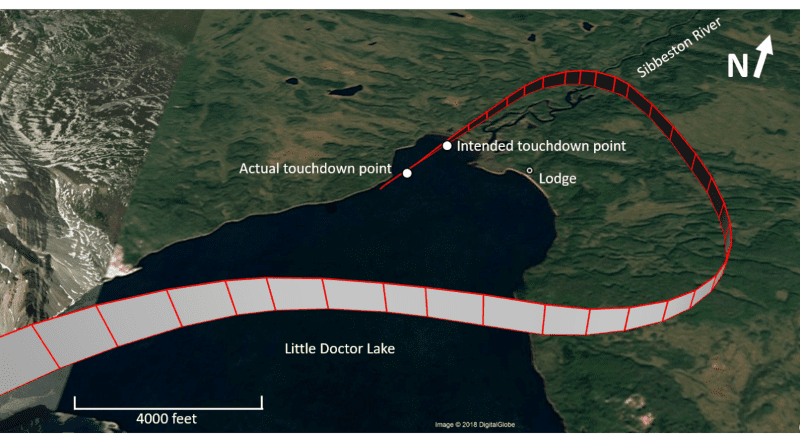The Transportation Safety Board of Canada published its investigation today into a plane crash on Little Doctor Lake where three people died in August of last year.
The lake is near mountains west of Fort Simpson and north of Nahanni Butte.
The report highlights the need for safety exits to be clear in case of an emergency.
According to the TSB’s investigation, the aircraft dropped altitude quickly in the last 300 feet before a rough landing. The right wing then hit the water and the plane tipped over.
Earlier this year, the TSB identified a safety issue with the Cessna 206 aircraft, which was involved in the crash. In its investigation, the TSB noted all doors were working properly but an extended wing flap blocked one of the rear doors from opening.
The report describes the events as follows,
“The pilot and one passenger were able to exit through the window in the pilot’s door and climbed up onto the floats. The pilot dove down to attempt to rescue the other passengers but was unable to open any doors. The pilot and surviving passenger were rescued by a nearby boater within 15 minutes. The three remaining occupants were unable to exit the aircraft and drowned; they were found inside the cabin with their seat belts undone.”
The three passengers that died are: Jean and Stewart Edelman, both 72-years old, from Saskatoon; and 33-year-old Geoffrey Dean from Castor, Alta.

A Google Earth image showing the aircraft’s descent. (Photo courtesy of the Transportation Safety Board).
Known issue
According to the TSB, the issue with blocked exits has gone on for years.
For example, in its safety advisory, it notes that Transport Canada, the U.S. Federal Aviation Administration and Cessna had been working on retrofit plans for the 206 fleet.
“However, the matter was dropped as no acceptable solution was found,” reads the advisory.
The TSB then concludes,
“As shown in this occurrence, without functional exits, the time required to exit the aircraft may increase, which in turn increases the risk of death in time-critical situations, such as when the aircraft is submerged or there is a post-impact fire.”
Weather, pilot training, safety briefing
In its final report, the TSB determined that weather wasn’t a factor in the crash. While it acknowledges that strong winds can occur near the lake as it cuts through a small mountain range, the conditions on the day were such that “it is unlikely that there was a gap wind of any significance.”
The pilot had started training on the Cessna aircraft on floats earlier that summer and completed the training successfully.
The report reads, “During the initial training, it was noted that the pilot had difficulty carrying out water landings in the manner preferred by the company. The pilot had a tendency to fly level near the surface of the water and then cut the power and drop onto the water. The company’s preferred method was to set a pitch attitude, controlling the descent with power, and land with power on. As the training continued, the pilot’s performance improved, and she was cleared for duty.”
The pilot had six successful flights with the aircraft in the previous week; she’d also landed successfully earlier in the day.
Finally, the report mentions the safety briefing given to passengers being incomplete. The briefing showed how to operate the back cargo doors, but not what to do if they were blocked by the flap, as was the case.
Since the crash, Simpson Air has stopped using Cessna 206 aircrafts as floatplanes. The company has also started training crew in underwater emergency exits.
- Read the full report here.
Francis was a reporter with CKLB from January 2019 to March 2023. In his time with CKLB, he had the immense pleasure and honour of learning about northern Indigenous cultures.






